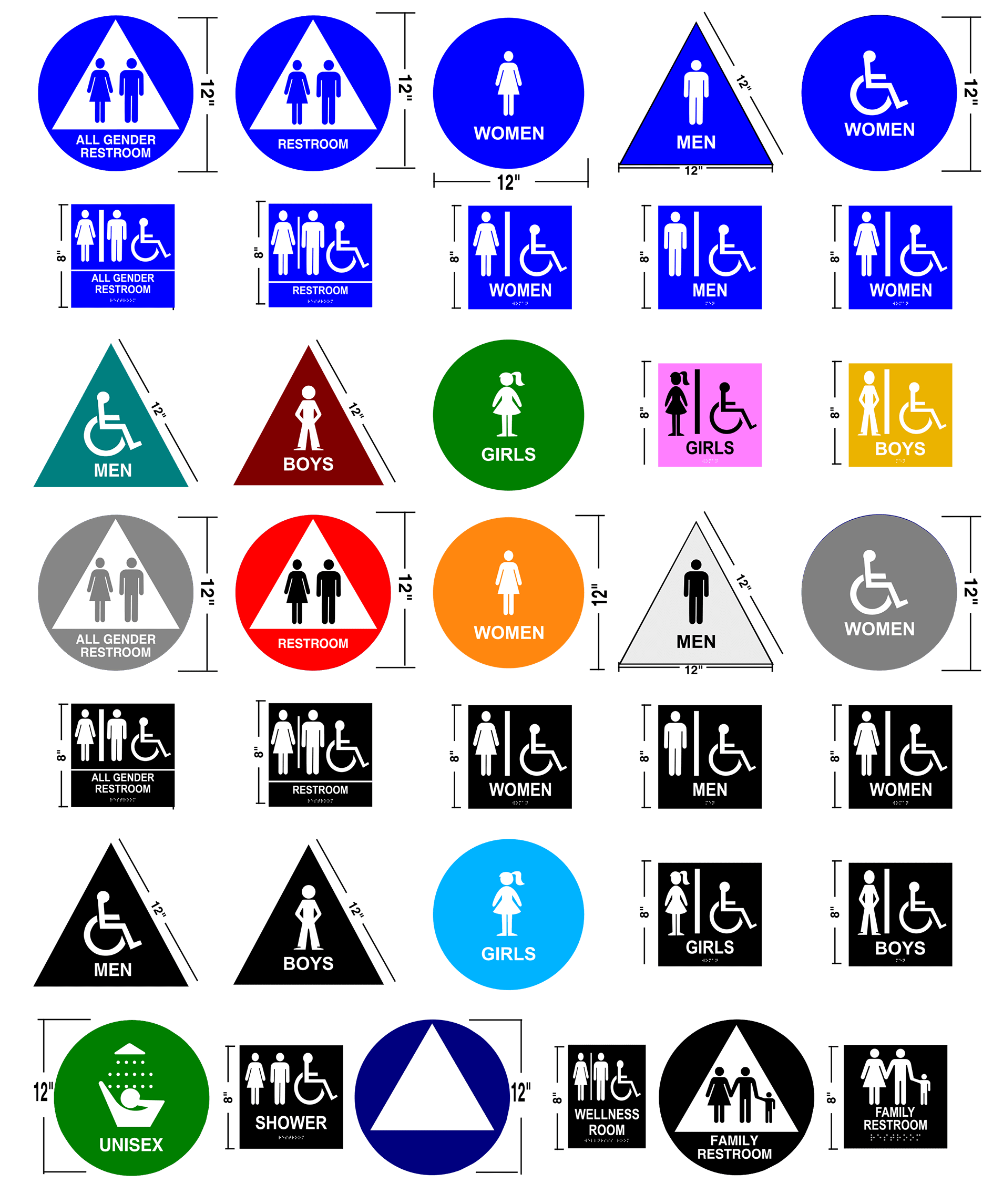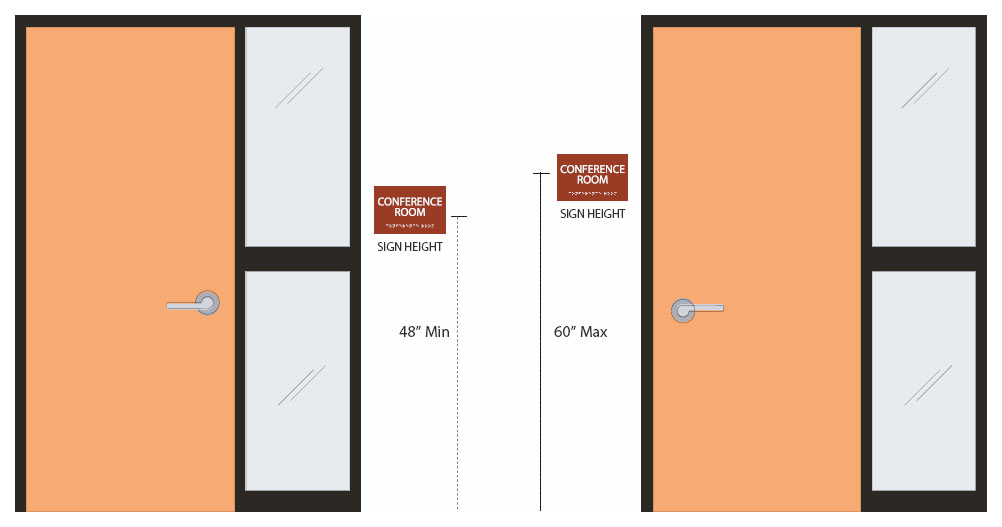ADA Signs: Vital Devices for Inclusive Atmospheres
ADA Signs: Vital Devices for Inclusive Atmospheres
Blog Article
Checking Out the Secret Functions of ADA Signs for Enhanced Accessibility
In the realm of accessibility, ADA signs offer as silent yet powerful allies, making certain that rooms are accessible and comprehensive for individuals with specials needs. By incorporating Braille and tactile elements, these indicators break obstacles for the aesthetically damaged, while high-contrast shade systems and understandable font styles provide to diverse aesthetic needs.
Relevance of ADA Compliance
Ensuring conformity with the Americans with Disabilities Act (ADA) is important for cultivating inclusivity and equal accessibility in public areas and workplaces. The ADA, enacted in 1990, mandates that all public centers, companies, and transportation solutions suit people with specials needs, ensuring they enjoy the very same civil liberties and opportunities as others. Compliance with ADA standards not only satisfies lawful responsibilities but also boosts an organization's reputation by showing its dedication to variety and inclusivity.
One of the key aspects of ADA compliance is the application of easily accessible signage. ADA indications are created to make sure that people with impairments can quickly navigate with spaces and structures.
In addition, adhering to ADA guidelines can mitigate the threat of possible fines and legal repercussions. Organizations that stop working to adhere to ADA guidelines may encounter charges or claims, which can be both economically difficult and harmful to their public image. Thus, ADA compliance is integral to fostering an equitable environment for everyone.
Braille and Tactile Components
The consolidation of Braille and tactile elements right into ADA signs symbolizes the concepts of accessibility and inclusivity. It is generally put below the equivalent message on signs to guarantee that individuals can access the details without visual assistance.
Tactile components prolong past Braille and consist of elevated personalities and symbols. These components are created to be discernible by touch, enabling individuals to identify area numbers, bathrooms, leaves, and other crucial locations. The ADA sets details standards concerning the size, spacing, and placement of these responsive elements to maximize readability and make sure consistency throughout various atmospheres.

High-Contrast Color Pattern
High-contrast shade plans play a critical function in improving the visibility and readability of ADA signs for individuals with aesthetic problems. These plans are vital as they take full advantage of the difference in light reflectance between message and background, making sure that indicators are easily noticeable, also from a range. The Americans with Disabilities Act (ADA) mandates the usage of certain color contrasts to suit those with minimal vision, making it a critical aspect of compliance.
The efficiency of high-contrast shades hinges on their capability to attract attention in different lights conditions, including dimly lit settings and locations with glow. Typically, dark text on a light history or light message on a dark background is utilized to achieve ideal contrast. Black message on a white or yellow history gives a stark visual difference that aids in quick acknowledgment and understanding.

Legible Fonts and Text Dimension
When taking into consideration the style of ADA signage, the selection of understandable typefaces and proper text size can not be overemphasized. The Americans with Disabilities Act (ADA) mandates that fonts must be sans-serif and not italic, oblique, manuscript, very decorative, or of uncommon form.
According to ADA standards, the minimal text height ought to be 5/8 inch, and it should raise proportionally with viewing distance. Consistency in message dimension adds to a cohesive visual experience, aiding people in browsing environments effectively.
Furthermore, spacing between lines and letters is indispensable to clarity. Adequate spacing protects against characters from appearing crowded, enhancing readability. By sticking to these criteria, developers can substantially enhance access, making sure that signage serves its designated function for all individuals, despite their visual capabilities.
Reliable Positioning Approaches
Strategic positioning of ADA signage is vital for maximizing accessibility and guaranteeing conformity with legal requirements. Effectively located indicators direct people with handicaps successfully, facilitating navigation in public areas. Trick considerations include exposure, height, and proximity. ADA guidelines state that signs need to be installed at an elevation between 48 to 60 inches from the ground to ensure they are within the line of sight for both standing and seated individuals. This common elevation range is crucial for inclusivity, enabling mobility device users and individuals of differing visit homepage heights to access info effortlessly.
In addition, indications have to be put nearby to the lock side of click now doors to allow simple identification prior to entrance. This positioning aids individuals situate spaces and rooms without blockage. In situations where there is no door, indicators need to be situated on the local surrounding wall surface. Uniformity in indicator positioning throughout a center boosts predictability, reducing confusion and enhancing general individual experience.

Conclusion
ADA indications play a crucial function in advertising accessibility by incorporating attributes that deal with the requirements of individuals with handicaps. Integrating Braille and responsive components makes sure critical info comes to the aesthetically impaired, while high-contrast color design and readable sans-serif fonts enhance exposure across different illumination problems. Effective placement methods, such as proper placing elevations and calculated locations, additionally help with navigation. These components collectively promote an inclusive environment, highlighting the value of ADA compliance in ensuring equal gain access to for all.
In the realm of availability, ADA indications serve as quiet yet powerful allies, ensuring that rooms are navigable and comprehensive for individuals with impairments. The ADA, passed in 1990, mandates that all public centers, companies, and transport solutions fit individuals with handicaps, guaranteeing they enjoy the same rights and possibilities as others. ADA Signs. ADA signs are designed to make sure that individuals with disabilities look what i found can conveniently browse via rooms and buildings. ADA guidelines state that signs ought to be placed at a height between 48 to 60 inches from the ground to ensure they are within the line of view for both standing and seated people.ADA signs play an important function in advertising accessibility by integrating attributes that resolve the needs of individuals with disabilities
Report this page